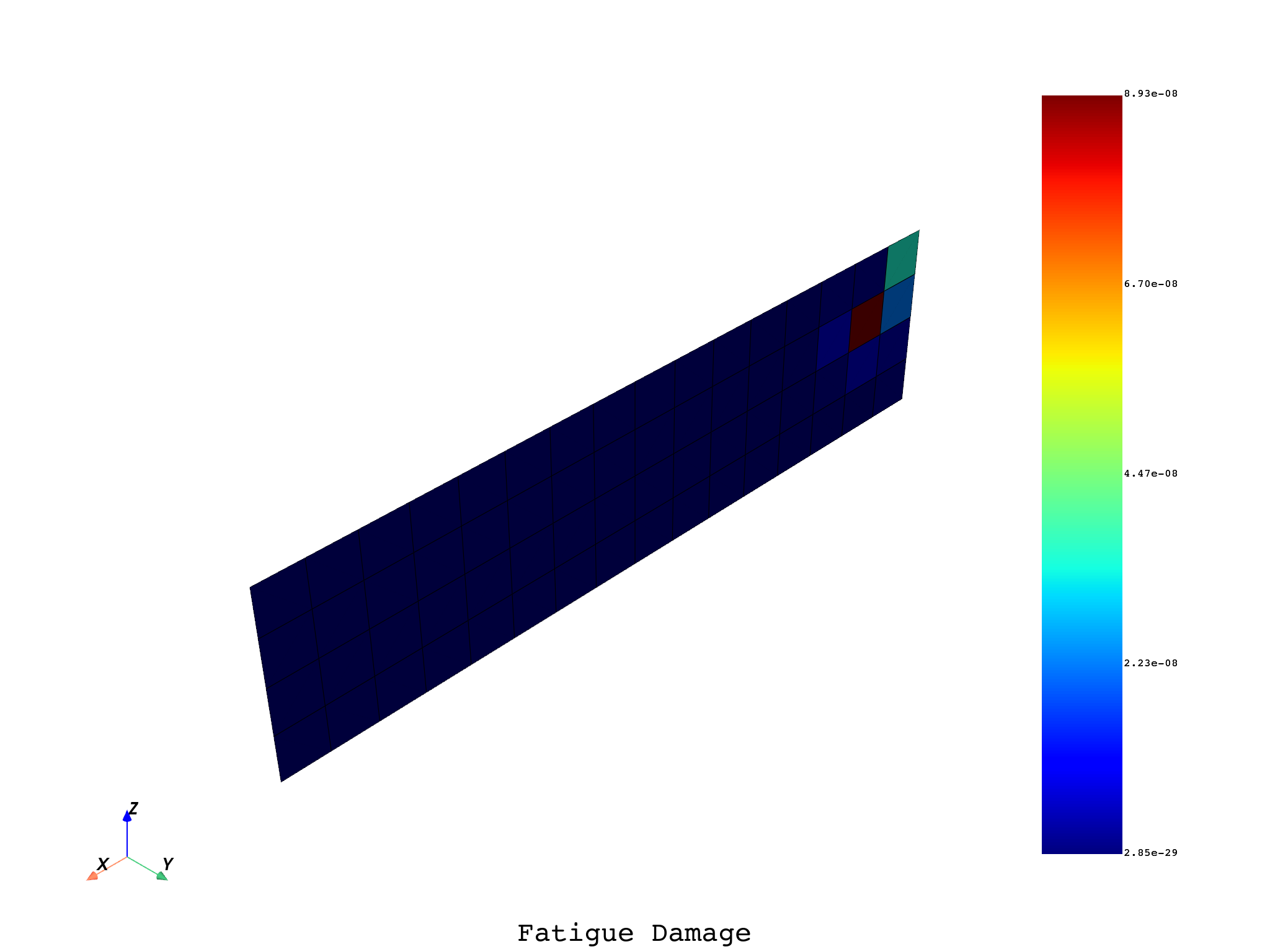Note
Go to the end to download the full example code.
Evaluate fatigue for a composite plate#
This example shows how to evaluate fatigue for a flat plate. It shows how you can use PyPDF Composites to select specific layers and define a custom combination method. For this example, the custom combination method is stress in fibre direction.
A random load time series is created. Taking into account that the load is assumed proportional, rainflow counting is applied to the load time series. Load ranges are then applied on the stress combination method, and damage is evaluated by using a dummy S-N curve.
Be aware that the fatpack package is not developed by Ansys, so it is the responsibility of the user to verify that it works as expected. For more information, see the fatpack package,
Note
When using a Workbench project,
use the composite_files_from_workbench_harmonic_analysis()
method to obtain the input files.
Set up analysis#
Setting up the analysis consists of loading the required modules, connecting to the DPF server, and retrieving the example files.
Load Ansys libraries and numpy, matplotlib and fatpack
import ansys.dpf.core as dpf
import fatpack
import matplotlib.pyplot as plt
import numpy as np
from ansys.dpf.composites.composite_model import CompositeModel
from ansys.dpf.composites.constants import Sym3x3TensorComponent
from ansys.dpf.composites.example_helper import get_continuous_fiber_example_files
from ansys.dpf.composites.layup_info import AnalysisPlyInfoProvider
from ansys.dpf.composites.select_indices import get_selected_indices_by_analysis_ply
from ansys.dpf.composites.server_helpers import connect_to_or_start_server
Start a DPF server and copy the example files into the current working directory.
Create a composite model
composite_model = CompositeModel(composite_files_on_server, server)
Read stresses and define a specific layer and a component of stress tensor#
Read stresses
stress_operator = composite_model.core_model.results.stress()
stress_operator.inputs.bool_rotate_to_global(False)
stress_fc = stress_operator.get_output(pin=0, output_type=dpf.types.fields_container)
stress_field = stress_fc.get_field_by_time_id(1)
Select layer P1L1__ModelingPly.2
analysis_ply_info_provider = AnalysisPlyInfoProvider(
mesh=composite_model.get_mesh(), name="P1L1__ModelingPly.2"
)
Select Sigma11 as the combination method
component = Sym3x3TensorComponent.TENSOR11
Load time series and apply rainflow counting#
A random time series is created. Load is assumed proportional, so rainflow counting can be directly done on the load time series to get the load ranges. No mean stress correction is applied.
number_of_times = 100
load_factor_time_series = np.random.normal(-1, 2.5, size=number_of_times)
x = np.linspace(1, number_of_times, number_of_times)
plt.xlabel("Load Index")
plt.ylabel("Load Factor")
plt.plot(x, load_factor_time_series, color="red")

[<matplotlib.lines.Line2D object at 0x7fe22cf33d90>]
Fatpack package is used for doing the rainflow counting
load_range_factors = fatpack.find_rainflow_ranges(load_factor_time_series)
S-N curve#
A dummy S-N curve is created. Note that this curve is not based on any experimental data. Sc is chosen to be twice the orthotropic stress limit in the fiber direction. and Nc is set to 1.
Sc = 2 * 1979
Nc = 1
s_n_curve = fatpack.LinearEnduranceCurve(Sc)
# Value for UD materials
s_n_curve.m = 14
s_n_curve.Nc = Nc
N = np.logspace(0, 9, 1000)
S = s_n_curve.get_stress(N)
line = plt.loglog(N, S)
plt.grid(which="both")
plt.title("Dummy Linear S-N curve")
plt.xlabel("Cycles to failure")
plt.ylabel("Stress range (MPa)")

Text(15.914246690538194, 0.5, 'Stress range (MPa)')
Damage evaluation#
Stress S11 at time 1 and layer P1L1__ModelingPly.2 are read for each load range. Its damage is evaluated using the dummy S-N curve.
damage_result_field = dpf.field.Field(location=dpf.locations.elemental, nature=dpf.natures.scalar)
with damage_result_field.as_local_field() as local_result_field:
element_ids = analysis_ply_info_provider.property_field.scoping.ids
for element_id in element_ids:
stress_data = stress_field.get_entity_data_by_id(element_id)
element_info = composite_model.get_element_info(element_id)
assert element_info is not None
selected_indices = get_selected_indices_by_analysis_ply(
analysis_ply_info_provider, element_info
)
# Load Range scaled by S11
s_11 = max(stress_data[selected_indices][:, component])
stress_ranges = load_range_factors * s_11
fatigue_damage = s_n_curve.find_miner_sum(stress_ranges)
local_result_field.append([fatigue_damage], element_id)
Plot damage
composite_model.get_mesh().plot(damage_result_field, text="Fatigue Damage")

Identify the element with the maximum damage#
maximum_element_scoping = damage_result_field.max().scoping
max_element_id = maximum_element_scoping[0]
print(f"The element with highest damage is {max_element_id}.")
print(f"The highest damage value is {damage_result_field.max().data[0]}.")
The element with highest damage is 27.
The highest damage value is 3.73710758910331e-07.
Total running time of the script: (0 minutes 3.472 seconds)

